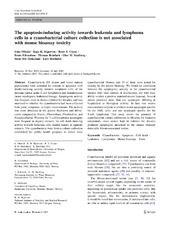| dc.contributor.author | Oftedal, Linn | en_US |
| dc.contributor.author | Skjærven, Kaja H. | en_US |
| dc.contributor.author | Coyne, Rosie T. | en_US |
| dc.contributor.author | Edvardsen, Bente | en_US |
| dc.contributor.author | Rohrlack, Thomas | en_US |
| dc.contributor.author | Skulberg, Olav M. | en_US |
| dc.contributor.author | Døskeland, Stein Ove | en_US |
| dc.contributor.author | Herfindal, Lars | en_US |
| dc.date.accessioned | 2011-03-11T10:54:21Z | |
| dc.date.available | 2011-03-11T10:54:21Z | |
| dc.date.issued | 2010-08-06 | eng |
| dc.Published | Journal of Industrial Microbiology & Biotechnology 1-13 | en_US |
| dc.identifier.issn | 1367-5435 | |
| dc.identifier.uri | https://hdl.handle.net/1956/4573 | |
| dc.description.abstract | Cyanobacteria (83 strains and seven natural populations) were screened for content of apoptosis (cell death)-inducing activity towards neoplastic cells of the immune (jurkat acute T-cell lymphoma) and hematopoetic (acute myelogenic leukemia) lineage. Apoptogenic activity was frequent, even in strains cultured for decades, and was unrelated to whether the cyanobacteria had been collected from polar, temperate, or tropic environments. The activity was more abundant in the genera Anabaena and Microcystis compared to Nostoc, Phormidium, Planktothrix, and Pseudanabaena. Whereas the T-cell lymphoma apoptogens were frequent in organic extracts, the cell death-inducing activity towards leukemia cells resided mainly in aqueous extracts. The cyanobacteria were from a culture collection established for public health purposes to detect toxic cyanobacterial blooms, and 54 of them were tested for toxicity by the mouse bioassay. We found no correlation between the apoptogenic activity in the cyanobacterial isolates with their content of microcystin, nor with their ability to elicit a positive standard mouse bioassay. Several strains produced more than one apoptogen, differing in biophysical or biological activity. In fact, two strains contained microcystin in addition to one apoptogen specific for the AML cells, and one apoptogen specific for the T-cell lymphoma. This study shows the potential of cyanobacterial culture collections as libraries for bioactive compounds, since strains kept in cultures for decades produced apoptogens unrelated to the mouse bioassay detectable bloom-associated toxins. | en_US |
| dc.language.iso | eng | eng |
| dc.publisher | Springer | eng |
| dc.rights | Attribution-NonCommercial CC BY-NC | eng |
| dc.rights.uri | http://creativecommons.org/licenses/by-nc/2.5/ | eng |
| dc.subject | Cyanobacteria | eng |
| dc.subject | Apoptosis | eng |
| dc.subject | Cell death | eng |
| dc.subject | Leukemia | eng |
| dc.subject | Lymphoma | eng |
| dc.subject | Mouse bioassay | eng |
| dc.subject | Toxic | eng |
| dc.title | The apoptosis-inducing activity towards leukemia and lymphoma cells in a cyanobacterial culture collection is not associated with mouse bioassay toxicity | en_US |
| dc.type | Peer reviewed | |
| dc.type | Journal article | |
| dc.description.version | publishedVersion | en_US |
| dc.rights.holder | Copyright The Author(s) 2010. This article is published with open access at Springerlink.com | |
| dc.rights.holder | The Author(s) 2010 | |
| dc.identifier.doi | https://doi.org/10.1007/s10295-010-0791-9 | |
| dc.identifier.cristin | 340182 | |
| dc.subject.nsi | VDP::Medical disciplines: 700 | eng |

